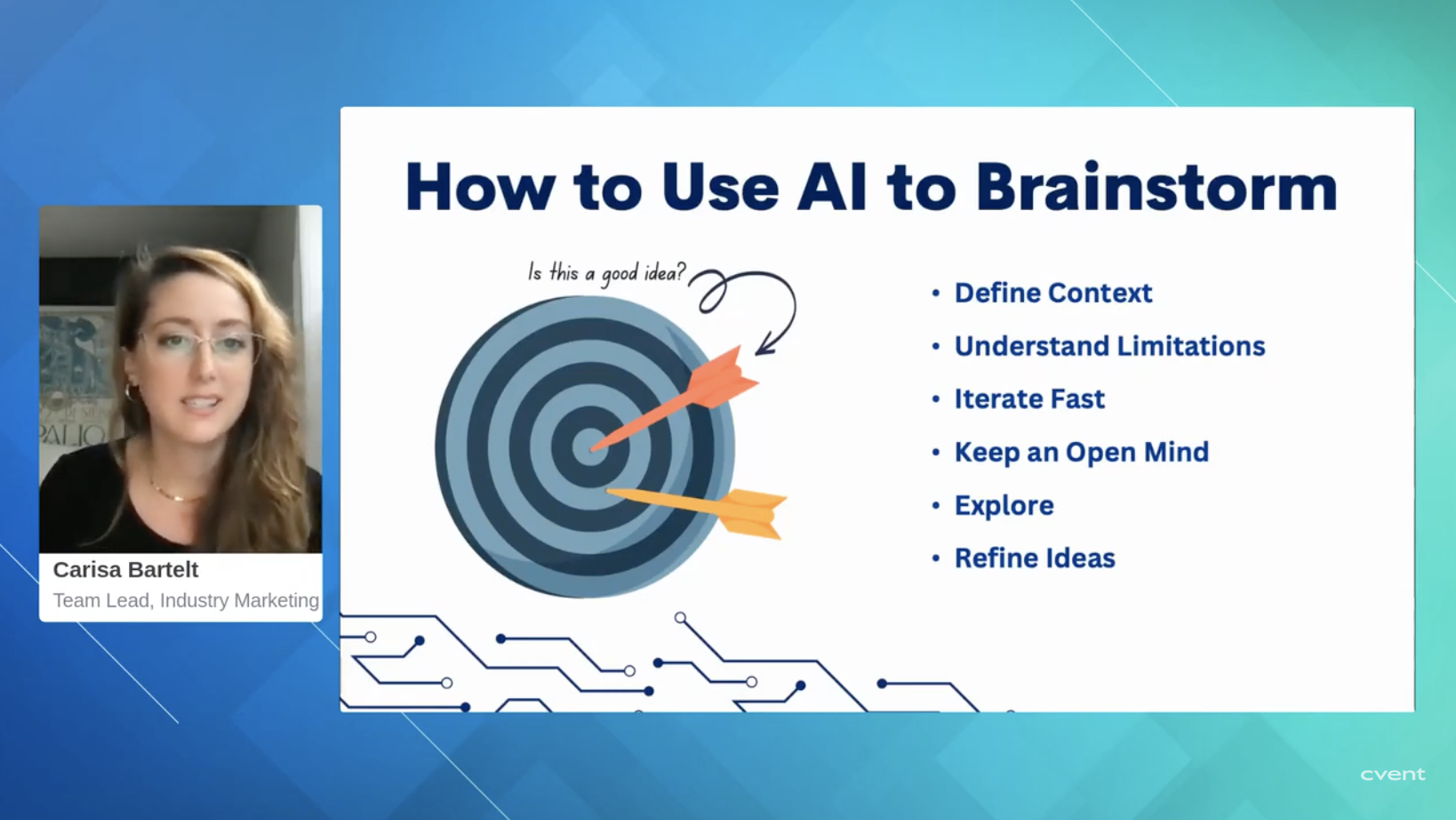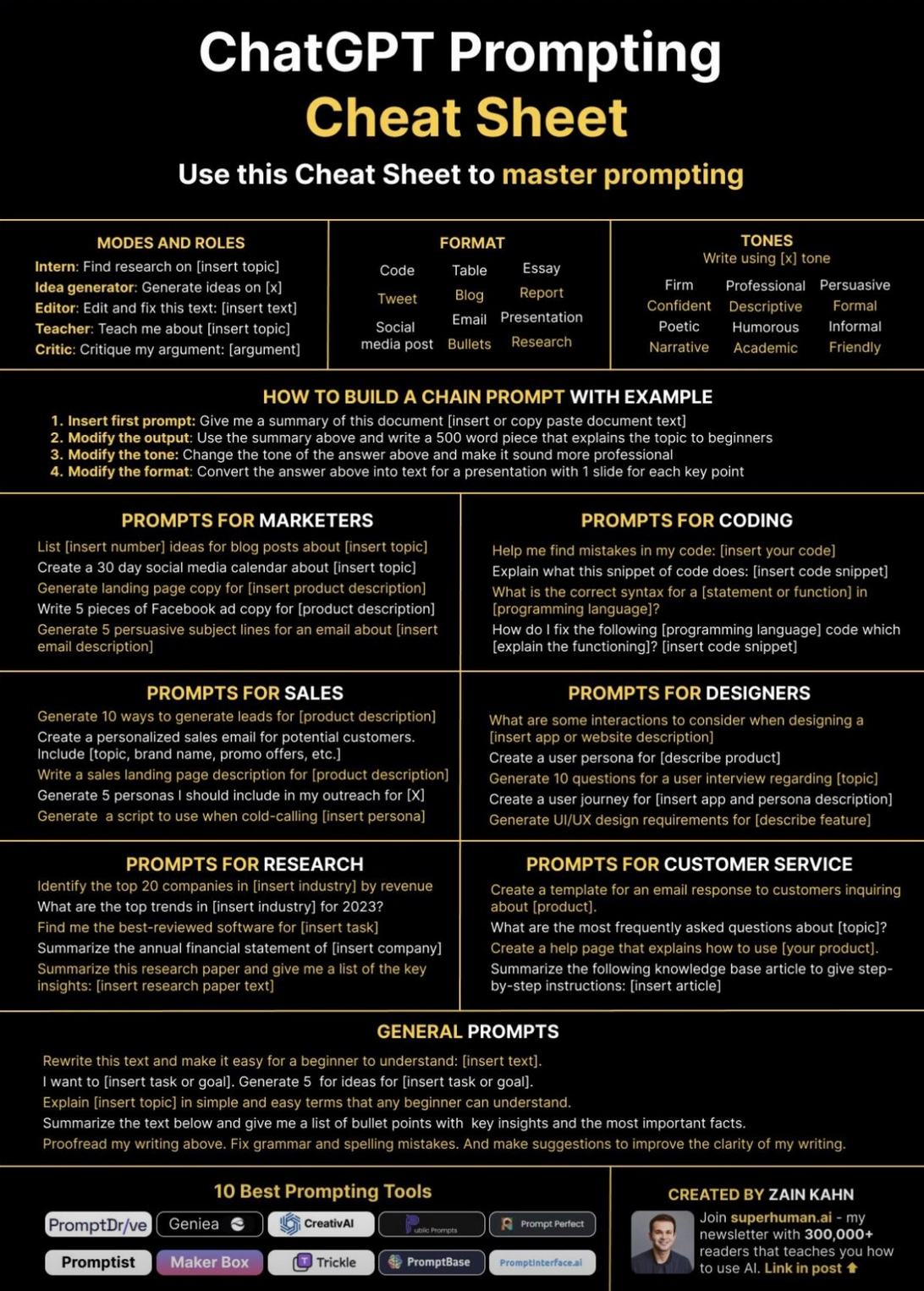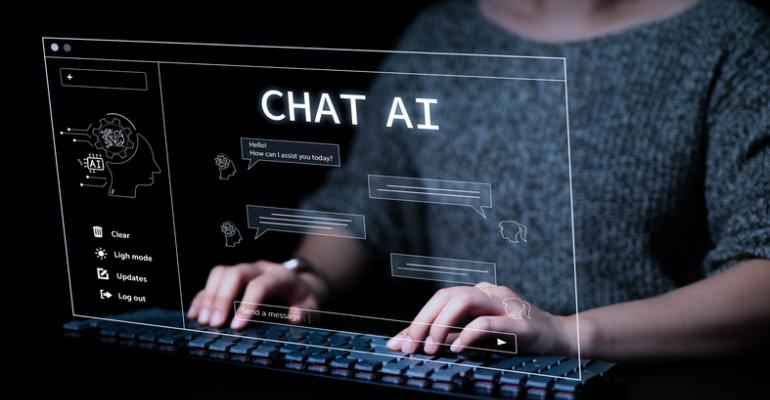When it comes to the use of artificial intelligence to build, promote, and analyze meetings held either in person or online, the planning industry has only scratched the surface. But some planners and marketers who are throwing themselves headlong into using A.I. for their meetings are also stepping up to help other planners get a handle on this rapidly advancing tool.
For instance, Brooke Gracey, director of marketing for meetings-industry technology giant Cvent, used ChatGPT, the chatbot from OpenAI that launched in November 2022, to help her build out nearly all the elements of a July 12 webinar she conducted for MeetingsNet’s audience, titled “Guide to Innovative Event Technology.” From that session-building experience plus a few others before it, she and fellow Cvent marketing lead Carisa Bartelt compiled several lessons for planners who are responsible for webinars on how to use A.I. chat to get better results in less time versus traditional efforts.
There is, however, one principle that should remain front and center as planners use ChatGPT for their events: “You have to maintain the human element and keep your unique voice in your marketing and your content,” Gracey says.
The reason for Gracey’s warning: It can be tempting for planners to rely too heavily on the results that come from ChatGPT when it’s prompted to complete a task. To an event’s human audience, it may be apparent that a marketing message or educational content is A.I.-derived, lessening the impact of the communication.
With that overarching thought in mind, planners can use Gracey’s and Bartelt’s advice, delivered in a recent webinar, to develop their own blueprint for planning webinars with the help of A.I.
Building an Agenda
ChatGPT is perhaps most powerful for planning teams in the ideation stage, when they must brainstorm topics and find presenters. “Starting from a blank slate is tough, which is why A.I.’s ability to present data-driven insights instantly is so valuable,” says Bartelt. “It gets the ball rolling and also allows you to go in directions you never would have thought of.”
Gracey cites her own recent experience: “For our webinar last month, our team first identified the goal and the main topic. From there, A.I. helped us refine the topic and identify various subtopics. Our webinar was about innovative event technology, so we asked ChatGPT: ‘What are some new technologies being used at events?’ From those results, we started to drill down: ‘How are holograms being used at events, and what are some dos and don’ts for doing that?’ We made sure to use open-ended questions to let A.I. have some leeway to give the widest range of relevant information.”
One key to getting the most from ChatGPT as you brainstorm is to be persistent. “If you type in a question or command and don’t get what you want, change some wording,” says Gracey. For instance, use different adjectives or ask for the perspective of someone in a different segment of your industry. “From that, more threads will appear. Keep refining your inputs and you will eventually get what you want.”
 Bartelt adds that planners have to be ready to “iterate quickly, because A.I. can spit out a lot of unusual ideas from your prompt. You must keep an open mind and be receptive to things you might not have thought of. Then you can select and blend different responses to meet your specific needs and preferences.”
Bartelt adds that planners have to be ready to “iterate quickly, because A.I. can spit out a lot of unusual ideas from your prompt. You must keep an open mind and be receptive to things you might not have thought of. Then you can select and blend different responses to meet your specific needs and preferences.”
ChatGPT can even help win over the sales team, the executive team, or other stakeholders on the approach to an event’s main topic and subtopics, says Bartelt. For example, “it can identify potential stakeholder concerns and help you organize the rationale behind your approach. In fact, A.I. can predict what certain executives will be concerned with or might object to,” which can help planners present a strong case for their chosen topics, tone, and format.
Building Marketing and Promotional Messages
“We have an A.I. writing assistant built into our event platform that will write session summaries that are most enticing to your audience, along with speaker bios,” Gracey notes. “The assistant can even use different conversational tones if you want to be creative or experiment.” One example Bartelt cites: asking the tool to work in the titles of popular songs from the 1980s to session titles and descriptions and their related marketing materials.
Gracey uses ChatGPT to create strategic marketing outlines and timelines as well as specific pieces of marketing content, such as 30-second “talk tracks” about the lessons attendees will learn in a session or a brief summary of a case study that will be presented.
In addition, “you can have A.I. create attendee personas from their demographics, interests, and behaviors” that the host organization has in its CRM database plus other sources, “and then produce different marketing messages” that use your baseline of required information with different emphases and tones, says Gracey. And “make sure to save the prompts you like for different personas and other results. That makes it easier to go deep more quickly for future events.”
However, just as with session content, “you cannot rely solely on A.I. to create these messages,” she stresses. “It gives you good starting points for what you want, but you must personalize things for your audience. A.I. often misses the nuance in human language, so it should be a supplement to your creativity.”
In short, planners have to take things the last mile to get an effective finished product. “Understanding A.I.’s limitations in areas like empathy and human touch are so important to using it well,” Bartelt says. “Humanizing the results you get by using your brand voice and your own voice is critical.”
Conducting Post-Event Analysis
From the real-time Q&A and chat-forum posts as well as post-event surveys and feedback, there’s an A.I. tool that can read transcripts and analyze all attendee input and find common themes and create summaries to help planners gauge that webinar’s effectiveness as well as identify enticing future webinar topics.
However, “A.I.’s analytical precision could miss nuance and oversimplify human responses, and deliver recommendations that don’t fully align with human needs,” Gracey notes. “The tool is designed to go through all the data” but the planning team must decide how much weight should be placed on each commonality that A.I. finds.
Bartelt notes that there are A.I. tools that can even analyze the speaker’s audio feed to find in which topic areas the speaker’s tone and pace were especially engaging or where they lost momentum. With some practice, planners can use A.I. to help presenters not just after an event but also in real time, she says.
Overall, using A.I. for webinars and in-person events will be a constant learning experience. “Some things you try will fall flat or be a bit awkward,” Bartelt says. “But you should keep trying things and keep learning and get better at it” because it can be so helpful.
A Cheat Sheet for ChatGPT
Zain Khan, creator of the Superhuman e-newsletter on how to leverage A.I. for business benefit, developed the following "cheat sheet" to help businesspeople better understand how to interact with ChatGPT.






